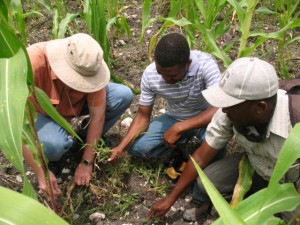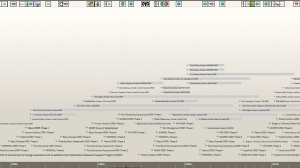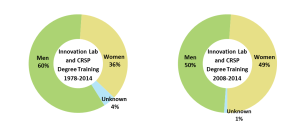Key Facts
Top
 Click from the list below for key facts about the Collaborative Research Support Program and Feed the Future Innovation Labs for Collaborative Research history, training and capacity building efforts, partnerships, and engagement with Feed the Future.
Click from the list below for key facts about the Collaborative Research Support Program and Feed the Future Innovation Labs for Collaborative Research history, training and capacity building efforts, partnerships, and engagement with Feed the Future.
Timeline and History
Capacity Building
US and Host Country Partners
Feed the Future and the Innovation Labs
Key Facts Flyer
——————————————————————————————————————————————————————————-
Timeline and History

Click on the icon to view the full timeline. The timeline is an ongoing project which tells the history of the Collaborative Research Support Programs and Feed the Future Innovation Labs for Collaborative Research.
Created in 1977, under Title XII of the International Development and Food Assistance Act of 1975, the CRSPs focus the scientific expertise of U.S. universities on improving agricultural productivity and marketing systems and enhancing food security in both the U.S and in developing countries.
The U.S. Congress authorized USAID to provide program support for long-term collaborative university research and coordination with other Federal and State efforts. In October 2000 Title XII was reauthorized, continuing these long-term collaborative university research programs “to achieve the mutual goals among nations of ensuring food security, human health, agricultural growth, trade expansion, and the wise and sustainable use of natural resources.”
As part of a larger strategy designed to integrate the many diverse aspects of its Feed the Future initiative, USAID’s agricultural research programs that were collectively known as the Collaborative Research Support Programs (CRSPs) are being rebranded. Each CRSP will henceforth be known as the “Feed the Future Innovation Lab for Collaborative Research on [a subject area].” The changes will be formalized as new grant agreements are signed, but informally all of the programs are being encouraged to use the Feed the Future Innovation Lab language.
Timeline: Collaborative Research Support Programs
——————————————————————————————————————————————————————————-
Capacity Building
From 1978 to 2013, at least 4,324 degrees were pursued by Feed the Future Innovation Labs for Collaborative Research and CRSP students, the large majority in graduate programs. Representing nearly 130 countries, about 25 percent of these students have come from Sub-Saharan Africa, with significant numbers also coming from Mexico, Philippines, Peru, Indonesia, and China. Their degrees have been granted in dozens of scientific fi elds, from agronomy, entomology, food science, to agricultural economics and other social sciences. The sex breakdown in recent years is moving towards an equal number of men and women when compared to a higher predominance of men in earlier years.
elds, from agronomy, entomology, food science, to agricultural economics and other social sciences. The sex breakdown in recent years is moving towards an equal number of men and women when compared to a higher predominance of men in earlier years.
Links best viewed in Internet Explorer or Google Chrome.
——————————————————————————————————————————————————————————-
US and Host Country Partners
The Innovation Labs and CRSPs are a unique partnership between U.S. universities, developing country individuals and institutions, and USAID Bureaus and Missions seeking solutions to hunger and poverty through agricultural research, training, and outreach. These partnerships include other Federal agencies, International Agricultural Research Centers including the Consultative Group for International Agricultural Research, non-governmental organizations, and the private sector. Typically, both the U.S. and host country institutions also make cash and in-kind contributions to the programs. These “matching” and leveraged funds range from 20% to over 100% of USAID support, making the Innovation Labs and CRSPs an extremely cost-effective mechanism.
US University Partner List 2012-2013
Current US University Partners by Innovation Lab and CRSP
Current US University Management Entities and Contact Information
Host Country Partners in Feed the Future Countries
Links best viewed in Internet Explorer or Google Chrome.
——————————————————————————————————————————————————————————-
Feed the Future and the Innovation Labs
The U.S. Government’s Feed the Future initiative supports country-driven approaches to address the root causes of hunger and poverty. The CRSPs are well positioned to achieve FTF objectives. The CRSPs focus on the best of US Universities scientific expertise and development experience to create new knowledge, to train students, farmers and entrepreneurs, and to tackle the thorniest of agricultural development questions. The Innovation Labs and CRSPs carry out USAID’s agricultural goals in each of the Feed the Future priority countries.
Learn about the Innovation Labs’ engagement in Feed the Future countries by clicking on the country in the list.
| Bangladesh | Guatemala | Liberia | Nepal | Tanzania |
| Cambodia | Haiti | Malawi | Rwanda | Uganda |
| Ethiopia | Honduras | Mali | Senegal | Zambia |
| Ghana | Kenya | Mozambique | Tajikistan |
CRSP Contributions to Feed the Future
Feed the Future and the Innovation Labs
Links best viewed in Internet Explorer or Google Chrome.
